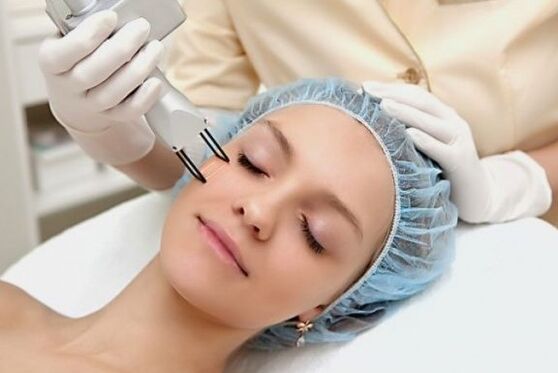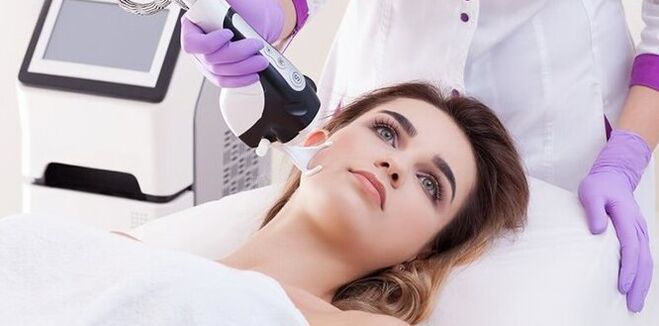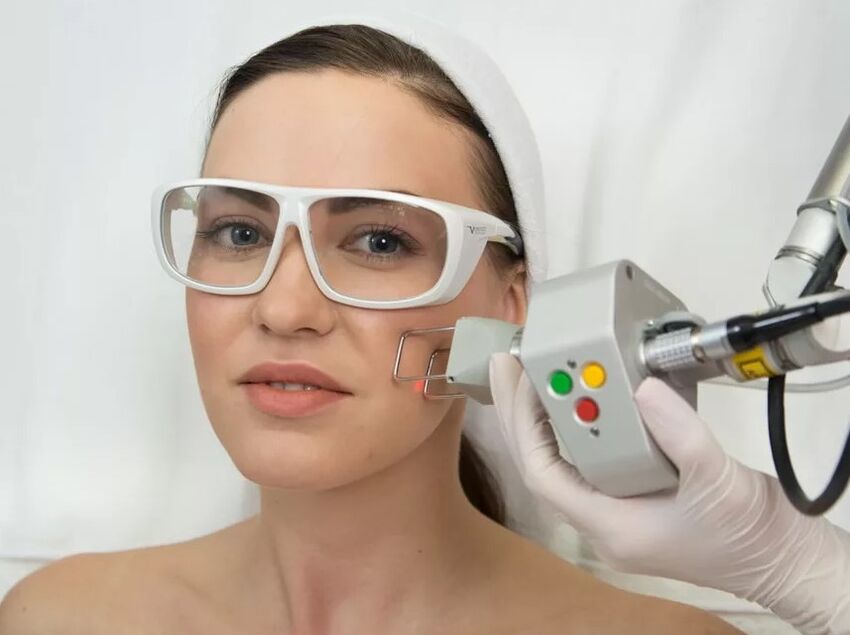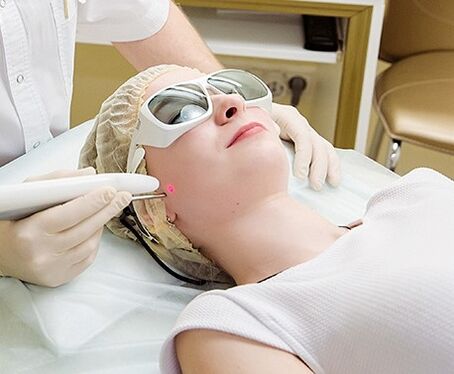"Stop, a moment! "-sooner or later every woman exclaims near Balzac age, looking in the mirror. And this is by no means due to the fact that this particular moment of her life is somehow excellent in a special way. No, the thing is that time flies too fast, and every moment takes a piece of youth and beauty with him. However, despite the fact that Chronos is an extremely stubborn deity, and no one has yet managed to agree with it, there is no reason to fall into despair: in the arsenal of modern cosmetology, as in the hat of the wizard, there is always a tool that can effectively resist the inevitable process of aging. For example, laser rejuvenation.

Types of laser rejuvenation
Low -temperature heating affects the processes inside the skin softly, without injuring the surface. At the same time, heating to high temperatures leads to the destruction and rejection of its areas. Therefore, first of all, laser rejuvenation technologies are classified according to the degree of their trauma for fabrics.
Ablation (ablative) rejuvenation
In ablative laser rejuvenation, high temperatures are used, under the influence of which tissue areas practically evaporate. Rather, intracellular fluids evaporate, and the cells themselves are burned. It sounds creepy, but the process occurs so quickly that the fabrics do not even have time to transmit warmth in deeper layers. This procedure is quite aggressive and associated with significant injury to the surface of the skin. But there are situations when only she can help.
For example, if you need to get rid of a rough scar, a deep scars or a serious post -acne hearth, the corresponding areas of the skin are simply burned with short laser impulses, destroying the epidermis and damaging the dermis. This triggers a powerful process of regeneration and intensive synthesis of collagen, as a result of which new skin appears, smooth and clean.
Typically, ablation technologies are used for:
- smoothing wrinkles (facial, mesh) and deep structural grooves or folds;
- neutralization of the manifestations of pigmentation and hyperpigmentation of the skin on the face, neck, in the neckline;
- elimination of the looseness of the skin;
- light and medium lifting;
- reduction of the severity of the post -acne;
- Smellating of striae (stretch marks) and scars.
High -temperature laser procedures are performed using Carbo Dioxide (CO2) or erbium laser. The first is able to provide the necessary temperature in the epidermis, the upper layers of the dermis and underlying tissues. The second - warms the skin to a much smaller depth (about 0. 4 mm).
Whatever the laser is used, high -temperature ablation technologies of laser rejuvenation are quite aggressive and significantly injure the surface of the skin.
Non-Ablative rejuvenation
Non-astride (non-bati) laser rejuvenation is based on relatively low-temperature effects on the deep layers of the skin and does not injure the surface of the skin. This technology has another name - photography.
The sparing effect of non-batilating procedures allows them to be used in any parts of the body. That's just to cope with the pronounced signs of aging these procedures, unfortunately, are incapable, therefore, it is recommended for people 25–35 years old.

Non -alert rejuvenation is used, first of all, in the fight against initial age -related changes, such as:
- the appearance of the first wrinkles;
- decrease in skin tone;
- Pigmentation violation.
They perform non -able laser rejuvenation, as a rule, with the help of a neodymium laser and erbic glass, the rays of which can penetrate into tissues to a depth of 1. 8–4 mm.
The use of Non-Blantive technologies does not require long-term rehabilitation, so they are used for the so-called express educational. A classic example of such a procedure is a Smooth pattern.
SMOOTHOOOTE
This procedure is very fond of business people who value their time: you must agree, it is extremely convenient to rejuvenate in 1 hour and not worry about the recovery stage.
With a Smooth reaching (from the English. Smooth-smooth, smooth, even, calm) epidermis and the upper layers of the dermis evenly warmed up using a long-pulse laser radiation. Since the process is non-bative (that is, it does not injure the skin) and the fabrics do not experience overheating, it can be used for all areas of the face and body, even for the skin above the mammary glands and the thyroid gland.
As a result of the procedure:
- The skin becomes more elastic and elastic;
- Small wrinkles are smoothed;
- pores narrow;
- The color of the skin improves and its tone is aligned.
As a rule, the effect of the Smooth unit is preserved for a long time: from six months to a year.
Field rejuvenation
Imagine a area of the skin that needs to be "processed" with a laser. You can do this in two ways:
- acting with a beam completely on the entire surface of the site;
- Having a beam, a point effect on the micro-ozones (fractions) inside the site, which is from 20 to 50% of its total area.
The first method is classic, the second was invented in the early 2000s and is called fractional.
Obviously, with high -temperature effects on the skin, the fractional method is much less traumatic. In this case, there is no complete (continuous) violation of the skin: each point zone exposed to the laser is adjacent to untouched healthy areas of the skin, which contribute to the rapid healing of spot microtrauks.
To achieve the desired effect of the procedure, use the finest micro-rays that form a laser grille (or fraction grid). Repeating the pattern of the fractional grid when penetrating into the skin, the laser beam does not hurt and does not injure the neighboring areas of the tissues.
The choice of the method of influence that is most suitable for a particular technology of laser rejuvenation can significantly affect the result of the procedure.

The fractional (point) effect of the laser on the skin is often used in ablative procedures to soften their inevitable adverse consequences. This reduces the rehabilitation period, eliminates the formation of a continuous itching crust during healing and allows the use of high -temperature laser technologies even in delicate areas in the eyelids or nasolabial triangle.
Field rejuvenation is widely used for:
- the appearance of wrinkles, creases, grooves and folds of any depth;
- hyperpigmentation or hyperkeratosis;
- gray shade of the face;
- skin dehydration;
- loss of the skin of natural turgor and elasticity;
- expanded pores;
- The manifestation of scars and stains is post -acne.
A striking example of such an anti -aging procedure is a fractional ablation laser grinding of the skin (otherwise - fractional thermolysis). Universal, effective, sparing enough - it is loved by cosmetologists and customers and, with competent execution, it is quite comparable in the result with much more serious cosmetological procedures (up to plastic surgery).
So, FRACTIONAL Ablationary anti -aging laser procedures are much softer in effect than classic ones, but still injure the surface of the skin (although in minimal sizes).
Neodymium rejuvenation
If we talk about the procedure of non-bative rejuvenation, then a neodymium laser is widely used for it. This device has a wavelength of about 1064 nm - 1320 nm, which explains the ability of its beam to penetrate as deep as possible into the skin (up to 4 mm). At the same time, the dermis warms up evenly, and the effect on the epidermis is practically absent.
The warmed collagen is compacted, the process of regeneration of existing fibers and the synthesis of new ones is activated. As a result, the skin becomes more smooth, elastic and toned, and the lifting effect occurs after the first procedure and lasts a long time (up to one and a half years).
In addition, a neodymium laser has proven itself in the fight against a vascular mesh, acne, pigmentation and even fresh scars, since its beam:
- It glues the walls of damaged vessels, excluding the flow of blood in them, as a result of which such "non -working" vessels become inconspicuous;
- kills bacteria that provoke the occurrence of acne, and inhibits the production of sebum;
- destroys excessively pigmented dermis cells;
- It increases the elasticity of the connective tissue in the place of a fresh scar and glues the walls of the vessels that feed it, as a result of which the scar is pale.
The procedure for neodymium rejuvenation is painless, after it there is no rehabilitation period (light redness of the skin passes within 1 hour), and the risk of complications and side effects is minimal. The advantages are obvious.
The Smooth union and non-abnormal rejuvenation of a neodymium laser work almost the same, but at different depths. Long pulses of the erbium laser used in the Smooth reinforcement, heating the upper layers of the skin to a depth of the order of 0. 4 mm, and neodymium radiation penetrates into the tissue to a depth of up to 4 mm. At the same time, the effect is on different structures of the skin (for example, the Ray of the Erbium laser does not reach the depths of capillaries or sebaceous glands and, accordingly, cannot affect them).

3D-, 4D- and 5D unit
More recently, laser rejuvenation in itself was quite revolutionary, and today you have to choose between laser 3D, 4D- and 5D unit.
In fact, everything is far from as mysterious as it sounds: 3, 4 and 5 is the number of stages of the corresponding procedure. Let us leave the letter D on the conscience of the one who came up with it. Although there is an opinion that D, familiar to us by the description of three -dimensional objects, belongs to the three main parameters of the skin - color, texture and elasticity. If you follow this logic, then we are talking about three-, four- and five-speed procedures for improving the color, texture and elasticity of the skin.
Recommendations for the recovery period after laser rejuvenation
After laser rejuvenation, a burning sensation, redness and swelling of the tissues, which usually pass within 1-3 days, are characteristic. In order to facilitate the recovery period after the procedure as much as possible, adhere to the following recommendations:
- Process damaged skin with dexpanthenol in the form of a cream, ointment or spray;
- after the disappearance of unpleasant consequences, go to the cream with hyaluronic acid and use it until the next course procedure; Moisten the skin with cream should be at least twice a day;
- Avoid direct sunlight and use a sunscreen with SPF protection factor at least 30 months after the procedure;
- Refuse to visit the pool, baths and saunas;
- Limit physical activity;
- Do not use scrubs and peels (both mechanical and chemical);
- Do not remove the resulting crusts at the site of the damage: they will come down themselves;
- Follow all the recommendations of the cosmetologist who conducted the procedure.
After Non-Blative, special rehabilitation laser procedures are not required, but there are still some recommendations, for example, after SMOOTH:
- Limit physical activity for the week;
- Forget about the bath, sauna and hot bath for 2-3 weeks;
- Refuse to visit the solarium for 3-4 weeks;
- When going outside, first use sunscreen.
The duration of the rehabilitation period after laser rejuvenation is individual for each specific case and depends on the characteristics of the patient's skin. Usually, with proper care and compliance with all requirements, recovery occurs after 7-10 days.






















